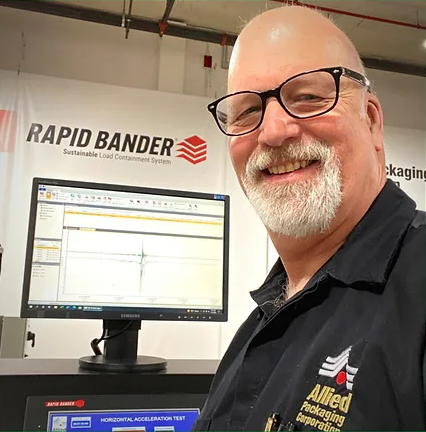Ask Steve
February 23, 2024
Question from Andrew: We are plagued with load failures, even though we have good force-to-load. If we put any more tension on, we will crush our boxes. If we have good FTL, why are we seeing so many load failures?
Hi Andrew, thanks for sending in your question. You may be surprised to learn that it is a very common problem.
You will be happy to know that it can be solved, it just requires the application of a little science.
Let’s start by understanding what is causing your load failures. Fundamentally, the job of the stretch wrap is to resist the forces that act upon the load during transportation with an equal and opposite force. To do that, two very important qualities need to be considered when we discuss load containment. The first is unitization (which is your Force-to-Load measurement). This is the force the film applies around the load, which is similar to the force your hand applies to an object when you pick it up. This force pulls all the boxes on your pallet together and prevents them from moving freely. As you have found, there is a limit to the amount of “unitizing force” you can apply before you start to crush or crease boxes. Tension and the number of wraps will dictate the amount of Force-to-Load. The film will naturally want to retract to some degree, once it is stretched, this is called memory. As it retracts, it will pull the load together. You can also increase Force-to-Load by adding more wraps. On the surface adding wraps may not make a lot of sense since you might be using the same tension or amount of stretch as before, but now suddenly you get a higher Force-to-Load??? Strech film has a “cling” quality similar to the Saran Wrap you have in your kitchen at home. You know how it will stick to itself (especially when you don’t want it to). As you apply additional wraps of film, the layers stick together effectively increasing the thickness of the film while magnifying the memory (or force) generated when the film retracts.
We have learned what Force-to-Load is and we have learned that there is a limit to how much force we can apply to some loads. We know that you have maximized this force and yet you still have continual load failures. That means there is another element to load containment that is missing in your containment standard. That element is called Secondary Stretch, or how much additional stretch the film will have when a force is applied after the pallet has been wrapped. Now we get into a paradox, the film must stretch to generate the Force-to-Load required to unitize your boxes, but we don’t want it to stretch any more after the load is wrapped. I will address that paradox shortly, but first let’s identify why your loads are failing. The film that is containing your load continues to stretch after you have wrapped the pallet and during transportation. This allows for excess movement which increases the load inertia causing the boxes stacked on the pallet to place even more force directly on the film. The more the force, the more it stretches and the more the boxes move until eventual load failure happens. I am discussing boxes because that is what you are shipping, but the same applies for bags, pails, and literally anything you can stack on a pallet. So, the second element of load containment is Secondary Stretch, and that is measured by the total amount the film is stretched after it has been applied to the load. We refer to this as Total Applied Stretch. Since it is obviously critical to load containment, you may ask why isn’t it a part of your load containment standard, like its counterpart Force-to-Load? The reason is straightforward, it is something that is not fully understood and that is why it is missing. As you stretch film the amount of force required to stretch it changes. It typically increases, then levels off, and at some stretch distance, it increases dramatically until it fails (breaks). Most stretch films are applied to loads in the level portion of the Stretch Force Curve where there is very little resistance needed for continued stretch. At higher levels of stretch, the film becomes more susceptible to puncture and web breaks. If you stretch the film enough to reach its maximum level of performance, any sharp corner of the pallet or a box will cause a web break. Tensions are turned down by the operators to counter that, but the Total Applied Stretch is also reduced along with your load containment. Film manufacturers test film to generate a force over distance curve (you may have heard the term Ultimate Strength) using a round drum to wrap the film around as force is being measured. While this is a great start, puncture and tear propagation also need to be considered because that is what the film will encounter in the real world, wrapping a pallet. (Unless you are shipping a single round drum.)
We have studied the physics of load failures to understand what happens, then using science, have developed a solution that addresses Secondary Stretch, the unspoken element of load containment.
Our solution uses two rolls of film, one full width and one banded. We mechanically narrow the edges of the bands through a set of rollers to form filaments. These are joined with the full web and laminated into it between the machine’s pre-stretch rollers, forming a single web with reinforcement filaments of roughly the same thickness as your conventional film. We can stretch the film much more (pre-stretch) before it is applied to the load because of the reinforcement filaments, taking most all the stretch out. You can use the same level of Force-to-Load as you currently do, but now the film will resist further stretching when forces are applied during shipment, keeping the load unitized and limiting movement. The reinforcement filaments will also prevent web breaks and if something does puncture the film, the hole will simply stop at the next filament without compromising load containment.
Because we stretch the film so much more than conventional film can be stretched, you will use 50%-60% less film per pallet, need fewer wraps (giving you more machine capacity) and cost less per pallet. But the most important thing for you is that it will eliminate your load failures without crushing your boxes!
Thanks for asking!








